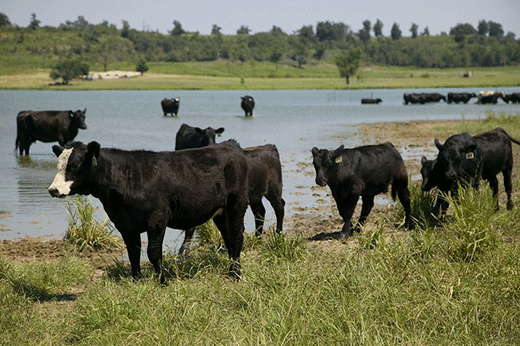
Water runoff in June and extreme heat in July have combined to heighten the risk of blue-green algae in ponds and other water sources. | Download this photo.
Heat, runoff heighten risk of blue-green algae in Kansas ponds and lakes
Cyanobacteria is toxic to livestock and other animals, says K-State veterinarian
July 3, 2019
MANHATTAN, Kan. – The extreme heat that hailed the end of June in Kansas combined with the heavy runoff from rains earlier in the month put many of the state’s waterways at risk to a waterborne toxin that could impact livestock and other animals around the farm.
Kansas State University veterinary toxicologist Steve Ensley said that the incidence of blue-green algae in farm ponds “has become more frequent in the last 15-20 years,” creating headaches for farmers who rely on those ponds to keep livestock hydrated during the hot, summer months.
When blue-green algae blooms, it creates a toxin that can affect the liver or the nervous system of animals that drink affected water. Animals may recover from toxins that affect the liver, but when they ingest toxins affecting the nervous system, those animals often die – sometimes within hours of exposure.
“There is no antidote for this toxin,” Ensley said. “If we have animals that look sick, we’ll try to do supportive care. If the damage is to the liver, there are things we can do to treat animals to get them over the initial damage they may have.”
But, he adds, “neurotoxins are very acute, so typically they lead to sudden death. In the last two years in Kansas, I have had grazing animals that have died…horses, cattle, sheep, goats and even dogs that swim in the water and drink as they’re swimming through the pond.”
Blue-green algae can form in a pond or other waterway from runoff that carries nitrogen or phosphorus into the body of water. The algae grow and bloom as temperatures reach 75 degrees or higher.
Farmers and others should be on the lookout for a blue, green or even orange color in the water. The bacteria will often give the impression of paint in the water, or a growth mat, according to Ensley. Blue-green algae is a threat to surface water only; it does not affect ground water. Well water typically is not affected.
“If you see something different about your pond or surface water, you need to investigate it,” Ensley said. “You need to get a sample taken and send it in to be tested.”
The Kansas State University Veterinary Diagnostic Lab can test water samples for blue-green algae, but Ensley said farmers can also work through their local veterinarian or extension agent.
Until water is confirmed safe, Ensley said farmers should keep animals away from the pond, and look for other ways to provide water to the herd.
“It takes about two weeks from when we see a bloom for it to get rid of the toxin,” Ensley said. “That’s kind of the guideline. Get them off that water for two weeks and then we can re-evaluate.”
For the future, Ensley noted that farmers can lessen the risk of toxins forming in their ponds by installing “as much grass and buffer strips between crop fields and surface water as possible so that we can slow down the movement of nitrogen and phosphorus into that water.”
Some short-term solutions to prevent algae blooms include installing solar-powered aerators to keep water moving; or adding water soluble dyes to the water, which block the amount of sunlight that can get to the pond.
For more information, talk with your local veterinarian or extension agent, or visit the K-State Veterinary Diagnostic Lab at www.ksvdl.org.

